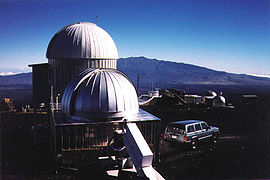
Mauna Loa Solar Observatory
Encyclopedia

Sun
The Sun is the star at the center of the Solar System. It is almost perfectly spherical and consists of hot plasma interwoven with magnetic fields...
located on the slopes of the Mauna Loa
Mauna Loa
Mauna Loa is one of five volcanoes that form the Island of Hawaii in the U.S. state of Hawaii in the Pacific Ocean, and the largest on Earth in terms of volume and area covered. It is an active shield volcano, with a volume estimated at approximately , although its peak is about lower than that...
volcano on the island of Hawaii
Hawaii (island)
The Island of Hawaii, also called the Big Island or Hawaii Island , is a volcanic island in the North Pacific Ocean...
, USA at an elevation of 11135 feet (3,393.9 m).
General information
The MLSO is operated by the High Altitude ObservatoryHigh Altitude Observatory
The High Altitude Observatory conducts research and provides support and facilities for the solar-terrestrial research community in the areas of solar and heliospheric physics, and the effects of solar variability on the Earth's magnetosphere, ionosphere, and upper atmosphere.HAO is a laboratory...
, which is a laboratory within the National Center for Atmospheric Research
National Center for Atmospheric Research
The National Center for Atmospheric Research has multiple facilities, including the I. M. Pei-designed Mesa Laboratory headquarters in Boulder, Colorado. NCAR is managed by the nonprofit University Corporation for Atmospheric Research and sponsored by the National Science Foundation...
. The observatory is tasked with monitoring the solar
Sun
The Sun is the star at the center of the Solar System. It is almost perfectly spherical and consists of hot plasma interwoven with magnetic fields...
atmosphere
Stellar atmosphere
The stellar atmosphere is the outer region of the volume of a star, lying above the stellar core, radiation zone and convection zone. It is divided into several regions of distinct character:...
and recording data on plasmic
Plasma (physics)
In physics and chemistry, plasma is a state of matter similar to gas in which a certain portion of the particles are ionized. Heating a gas may ionize its molecules or atoms , thus turning it into a plasma, which contains charged particles: positive ions and negative electrons or ions...
and energetic
Energy
In physics, energy is an indirectly observed quantity. It is often understood as the ability a physical system has to do work on other physical systems...
emissions from the chromosphere
Chromosphere
The chromosphere is a thin layer of the Sun's atmosphere just above the photosphere, roughly 2,000 kilometers deep....
and corona
Corona
A corona is a type of plasma "atmosphere" of the Sun or other celestial body, extending millions of kilometers into space, most easily seen during a total solar eclipse, but also observable in a coronagraph...
. Studies of Coronal Mass Ejection
Coronal mass ejection
A coronal mass ejection is a massive burst of solar wind, other light isotope plasma, and magnetic fields rising above the solar corona or being released into space....
s (CMEs) are conducted at MLSO. All data are available from the MLSO web page: http://mlso.hao.ucar.edu
Instruments
The MLSO contains instruments to record images of the solar disc and limb, every 3 minutes between 17:00 UT and 0230 UT weather permitting. The instruments currently operated at the observatory are:- MK4 K-Coronameter - White Light Corona (field-of-view: 1.09 to 2.79 solar radii)
- PICS Ha Limb/Disk - Chromosphere ~ 1600 km Decommissioned
- Coronado Solarmax 60 Ha Limb/Disk Imagining - Chromosphere ~
- CoMP Coronal Multi-channel Polarimeter - Near IR Coronal Polarimeter
- CHIP Helium-I Imager - Chromosphere ~ 2000 km and coronal holes
- PSPT - Photosphere (surface) and the chromosphere ~ 400 km
The site is shared with the Mauna Loa Observatory
Mauna Loa Observatory
The Mauna Loa Observatory is an atmospheric baseline station on Mauna Loa volcano, on the big island of Hawaii.-The observatory:Since 1956 Mauna Loa Observatory has been monitoring and collecting data relating to atmospheric change, and is known especially for the continuous monitoring of...
run by the National Oceanographic and Atmospheric Administration at coordinates 19°32′10"N 155°34′34"W, about two miles north of Mokuaweoweo, the summit of Mauna Loa.

